Abstract
Objective
The aim of this multicenter, matched-pair study was to compare the outcomes of stereotactic radiosurgery (SRS) and conventional external radiation therapy (RT) when used as a primary treatment in spine metastasis from hepatocellular carcinoma (HCC).
Methods
From 2005 to 2012, 28 patients underwent SRS as the primary treatment in spine metastasis from HCC. Based on sex, age, number of spine metastasis, Child-Pugh classification, interval from original tumor to spine metastasis, and year of treatment, 28 patients who underwent RT were paired. Outcomes of interest were pain relief, progression free survival, toxicities, and further treatment.
Results
The perioperative visual analog scale (VAS) decrease was larger in SRS group than in RT group, but the difference was not significant (3.7 vs. 2.8, p=0.13). When pain medication was adjusted, the number of patients with complete (n=6 vs.3) or partial (n=12 vs.13) relief was larger in SRS group than in RT group; however, the difference was not significant (p=0.83). There was no significant difference in progression free survival (p=0.48). In SRS group, 32.1% of patients had 1 or more toxicities whereas the percentage in RT group was 63.0%, a significant difference (p=0.04). Six SRS patients and 7 RT patients received further intervention at the treated segment.
Hepatocellular carcinoma (HCC) has been well known that high incidence is in eastern Asia and that its incidence is quite low in Europe and Unites States1118). Because of the improved duration of control of the primary tumor site and improvements in imaging systems, bone metastases are noted much more frequently in HCC1417).
The role of stereotactic radiosurgery (SRS) in the treatment of spine metastasis from HCC has been rarely reported16). On the other hand, the role of conventional external radiation therapy (RT) in the treatment of spine metastasis from HCC has been the subject of controversy914). HCC has not been considered as radiosensitive as breast, prostate, lymphoma, seminoma, and myeloma; however, there is controversy about the radiosensitivity of HCC14).
Recently we reported that SRS provided better pain relief and better local control than that obtained from RT, when those procedures are performed as a primary treatment in spine metastasis from renal cell carcinoma (RCC)26). However, RCC is notorious for resistance to RT. The results presented in this study cannot be extrapolated to spine metastasis from HCC without verification. Recent report insisted that local progression free survival was better in SRS group than that in RT group4). However, Child class, Karnofsky performance scale, and overall survival of SRS group were significantly better than those of RT group in this study4).
The aim of this multicenter, matched-pair study was to compare outcomes of SRS and RT when used as the primary treatment in spine metastasis from HCC.
Retrospective data were collected from Ilsan Paik Hospital, Korea Cancer Center Hospital, St. Vincent's Hospital, and Seoul National University Hospital. This study was approved by the institutional review boards at the 4 participating hospitals. From 2005 to 2012, 290 metastatic spine disease patients underwent SRS at 2 hospitals. Among those patients, 40 had HCC as the primary tumor. Twelve patients were excluded because they underwent previous other treatments. The remaining 28 patients underwent SRS as a primary treatment and were included in this study's SRS group.
From the same period, a cohort of 1602 patients treated with RT as a primary treatment for spine metastasis was identified from another 2 facilities. During the study period, SRS was not available in these hospitals and, therefore, RT was performed. Among those, 113 patients had HCC as the primary tumor. Twenty-one patients were excluded because of previous surgery. The remaining 92 patients underwent RT as a primary treatment. Patient cohort was the same as that in our previous article26).
The RT patients were matched with SRS patients on a 1 : 1 basis. A multidisciplinary panel consisting of spine surgeons and radiation oncologists decided on the matching criteria. The matching criteria were sex, patient age, number of spine metastasis, Child-Pugh classification, time interval from original tumor diagnosis to spine metastasis segment, and year of treatment. Based on those criteria, 28 of the 92 patients who underwent RT as a primary treatment were enrolled in the RT group.
The Eastern Cooperative Oncology Group (ECOG) scale system was used to measure performance status in this study. Ambulatory level was scored as 1 for ambulatory with no deficits, 2 for ambulatory with a limp, 3 for use of a cane or walker, 4 for wheelchair requirement, and 5 for bedridden7).
Mean follow-up period after treatment was 11.29±13.97 months and 11.32±8.52 months in the SRS and RT groups, respectively.
The primary outcomes of interest were pain relief and progression free survival. Secondary outcomes of interest were treatment toxicities and the need for further treatment. Although many patients had longer follow-up periods, pain relief in most patients was achieved in 4 weeks for the majority of patients in a clinical trial1227). Thus, the time point chosen for assessment of treatment effectiveness was 1 month after treatment completion. In the SRS and RT groups, pain levels were recorded before treatment and at the 1-month follow-up visit by using a visual analog scale (VAS). The VAS scores ranged from 0 (no pain) to 10 (the worst imaginable pain). Complete pain relief was defined as a complete absence of pain without the need for analgesics. Partial pain relief was defined as reduction of pain by achieving a decrease in VAS score of more than 2 with a stable or decreased use of pain medication. Stable pain was defined as the same VAS score or as a decrease in VAS score of less than 2. Pain progression was defined as any increase in VAS score or by an increased pain medication119). Pain medication was defined as narcotics, steroids, or over the counter pain medications, used for pain relief12).
Images from axial and sagittal spine magnetic resonance imaging (MRI) and/or computed tomography (CT) were obtained. Those images were reviewed by a spine surgeon and by experienced neuroradiologists to assess local recurrence. The final written radiology report was also referenced.
Toxicities following SRS or RT were reported and graded by using the common toxicity criteria of the Radiation Therapy Oncology Group (RTOG)5). Vertebral compression fracture was defined as a de novo fracture (i.e., a new endplate fracture or collapse deformity when compared with before treatment status) or as fracture progression of an existing fracture at the treatment site6). Compression fracture induced by tumor progression was not considered an indicator of toxicity21).
The SRS was performed by using a Novalis shaped beam radiosurgical unit (Brain LAB, Heimstetten, Germany) or by using a Cyberknife™ (Accuray, Inc., Sunnyvale, CA, USA). The SRS procedures in each center have been previously described in detail3102426). The prescribed dose or radiation was determined according to the shape of the tumor and the distance between the tumor margin and the spinal cord. In cases when the tumor margin abutted the spinal cord dura, fractionation was determined as 3 to 5. When the tumor margin was more than 3 mm away from the dura, single session radiosurgery was planned. In general, tumor volume which was covered by the prescription dose was more than 90% (mean, 96%).
In RT, no restrictions were placed on machine energy. Either parallel opposed or three fields were used. Doses were prescribed at mid-spine26).
To compare the various fractionation schedules, the biological effective dose (BED) was calculated13). In addition, dose was calculated as a 2-Gy equivalent normalized BED (nBED). The nBED was calculated by dividing BED by [1+d/(α/β)], where d is 2 Gy, and for the tumor tissue early effect, α/β is 10 (Gy2/10)(Fig. 1).
Number of spine metastasis was compared between two groups by using Wilcoxon signed ranks test. Other continuous variables were compared by using paired t-tests. Pain relief was compared by using Bowker's test of symmetry. Other categorical variables were compared by using McNemar tests. The stratified log-rank test was used to assess differences in distributions between groups. A two-tailed p value of <0.05 was considered indicative of a significant difference. SPSS for Windows version 21.0 (SPSS Inc., Chicago, IL, USA) was used for statistical analysis.
Patient characteristics were compared between the SRS and RT groups. Both groups were not significantly different in sex (male : female, 26 : 2 in both groups), age (58.7 vs. 59.7 years, p=0.54), time interval from original tumor diagnosis to spine metastasis (17.7 vs. 18.4 months, p=0.85), Child-Pugh classification (p=1.00), number of spine metastasis (p=0.72), pretreatment ECOG status (p=0.58), pretreatment ambulation status (p=1.00), tumor volume (33.1 vs. 42.4 cc, p=0.23), and pretreatment VAS (6.8 vs. 5.6, p=0.06) (Table 1). Mean total margin dose was 35.4±9.5 Gy and 31.5±6.7 Gy in the SRS and RT groups, respectively (p=0.10). Mean number of fractions was 4.0±1.5 in the SRS group and 10.2±2.8 in the RT group. Mean nBED was significantly higher in the SRS group than that in the RT group (58.4 vs. 33.7 Gy2/10, p=0.0001) (Table 1). Median overall survival after treatment was 8 months and 10 months in the SRS and RT groups, respectively. Overall survival after treatment was not significantly different between the two groups (p=0.85) (Fig. 2).
Compared to pretreatment scores, post-treatment VAS scores were significantly lower in both the SRS (6.8 vs. 3.1, p=0.0001) and RT (5.6 vs. 2.7, p=0.0001) groups. When perioperative VAS score changes were compared between SRS and RT groups, the decrease in VAS scores was larger in the SRS than that in the RT group, but the difference was not significant (3.7 vs. 2.8, p=0.13). When pain medication was adjusted, the number of patients with complete (n=6 vs. 3) or partial (n=12 vs. 13) pain relief were different in the two groups; however, the difference was not significant (p=0.83) (Table 2).
Six patients in the SRS group underwent further intervention at the index segment; 3 patients underwent vertebroplasty/kyphoplasty, 2 patients underwent SRS, and 1 patient underwent RT. Mean interval after SRS was 5.2 months. Seven patients in the RT group received further intervention at the index site; 2 patients underwent surgical intervention, 3 patients underwent vertebroplasty/kyphoplasty, and 2 patients underwent SRS. Mean interval after RT was 7.1 months. The interval from first treatment to further intervention was not significantly different between the two groups (5.2±3.9 vs. 7.1±3.8, p=0.38) (Table 2).
All surgery, SRS, and RT among further treatments were performed due to tumor progression. However, in SRS group, 2 patients underwent kyphoplasty due to compression fracture (no tumor progression) and 1 patient underwent vertebroplasty due to tumor progression. In RT group, 1 patient underwent vertebroplasty due to compression fracture (no tumor progression), 2 patients underwent vertebroplasty due to tumor progression (Table 2).
Forty seven (83.9%) patients (SRS group, n=24; RT group, n=23) underwent follow-up MRI after primary treatment. The actuarial local control rates for the spine metastases treated with SRS were 92%, 92%, 80%, 59%, and 25% at 1, 2, 3, 6, and 12 months after SRS, respectively. The actuarial local control rates for the spine metastases treated with RT were 92%, 87%, 78%, 64%, and 32% at 1, 2, 3, 6, and 12 months after RT, respectively. Median progression free survival after treatment was 10 months in the SRS group and 8 months in the RT group.
In the SRS group, 32.1% (9/28) of the patients had 1 or more toxicities, whereas the percentage in the RT group was 63.0% (17/28), significantly higher percentage (p=0.04) (Table 2). All morbidities were RTOG grades 1 to 2. There were 2 grade 2 gastrointestinal toxicities in the SRS group. There were 5 grade 2 gastrointestinal toxicities in the RT group. There was 1 grade 2 skin toxicity in the RT group (Table 3).
The most common toxicity was gastrointestinal toxicity in both groups. Compression fracture occurred in 5 patients of the SRS group and 1 patient of the RT group. This difference was not statistically significant (p=0.22). Two of the compression fracture in the SRS group underwent kyphoplasty after SRS at index level. The one compression fracture in the RT group underwent vertebroplasty after RT at index level.
In this study, we attempted to control potential confounding factors in case when patients who underwent RT were matched with those who underwent SRS. The matching criteria were based on those used in previous studies712) and on prognostic factors associated with metastatic spine tumor11214). Finally, a multidisciplinary panel decided on the criteria.
None of the patient parameters in our two groups were significantly different (Table 1). In addition, we compared overall survival after treatment between the SRS and RT groups to evaluate the patients' systemic burden428), and overall survivals in the two groups were not different (Fig. 2).
Moreover, we only included patients who underwent SRS or RT as the primary treatment. Even though retreatment with SRS was reported to be effective310), we only included patients with SRS and RT as their initial treatment in order to reduce the effects of potential confounding factors as much as possible.
In this study, nBED delivered was significantly higher in the SRS group than in the RT group (Table 1). Reports on the correlation of dose with response rate have been contradictory1114). Based on our study results, we could not support that high dose SRS with a low fraction schedule is more effective on pain relief and local control than low dose RT with a high fraction schedule in the treatment of spine metastasis from HCC. However, further studies are warranted to elucidate effective dose-fraction schedule.
Many authors consider pain control, not local control, as a key treatment outcome21); however, other authors consider local control as the key outcome2820). In our study, we considered both of those endpoints. With regard to pain relief, we not only measured patients' VAS pain scores but also considered pain medication adjustment when determining pain score changes because that approach is more rigorous and more objective1).
Among our SRS subjects, there were 18 patients (64.3%) with adjusted complete or partial pain relief; when unadjusted, 25 patients (89.3%) exhibited an improvement in pain score. These results are similar to those in a previous study (i.e., 84.6% pain relief)16).
In contrast, among the RT patients, there were 16 patients (57.2%) with adjusted complete or partial pain relief; when unadjusted, 21 patients (75%) exhibited an improvement in pain score. These results are similar or a little worse than those in previous studies (i.e., 72.7-99.5%)11141523).
Regarding radiological progression free survival, our data showed similar levels of durable local control in both the SRS and RT groups. Progression in another spine level that developed before index level progression was also similar in both groups. In addition, the time interval from the first treatment to further intervention was not significantly different between the two groups. On the other hand, surgical intervention was needed in 2 patients in the RT group, but in none of the SRS group (Table 2). Overall, clinical and radiological outcome in both groups was not significantly different.
In our study, toxicities developed in 32.1% (9/28) of the SRS group and in 63.0% (17/28) of the RT group. This tendency is consistent with previous reports in which RT patients had more morbidities than SRS patients712). The difference in morbidities may be the result of the relatively limited capability to exclude normal tissue from RT treatment and the need for multiple fractions in RT.
Vertebral compression fracture risk after SRS has been reported to range from 11% to 39%, higher than the fracture risk after RT (<5%)2122). In this study, compression fracture occurred in 5 patients (17.9%) in the SRS group and in 1 patient (3.6%) in the RT group. Two SRS group patients underwent kyphoplasty and 1 RT group patient underwent vertebroplasty after compression fracture. The dose per fraction in all compression fracture patients was less than 20 Gy, which is lower than the previously reported threshold for compression fracture risk (≥20 Gy)622).Osteolytic tendency in most spine metastasis from HCC may also affect compression fracture14).
In Korea, SRS has been covered by the national health insurance system since 2011. In Korea, if SRS is done in 3 fractions and RT is done in 10 fractions, the cost of SRS is similar to that of three-dimensional RT25). The cost of SRS treatment in Korea is considered less than that in the USA where the cost of 3D RT is reported to be 71% of that of SRS12).
In this study, pain relief and local control rate were not significantly different between the SRS and RT groups. However, with regard to toxicities, the rate in the RT group was significantly higher than that in the SRS group. When we consider the number of fraction is less in SRS than in RT, SRS must be a good alternative as a primary treatment in spine metastasis from HCC.
Several limitations of this study should be noted. First, although this is a matched-pair study, the enrolled SRS and RT patients were collected retrospectively, which can result in a selection bias. SRS and RT technique is also different in each center. Second, our sample size was low (n=28) in both groups. If more cases are included, we admit that the difference of outcomes such as pain relief could be significant. Regardless, this study reports on the largest series of cases with SRS as a primary treatment on HCC spine metastasis to date. Third, many spine metastases in this study were oligometastases (≤3). Therefore, the study results cannot be generalized to adjuvant treatment or widespread spine metastasis. Nevertheless, to our knowledge, this is the first multicenter study that compared the outcome of SRS with that of RT when used as a primary treatment of spine metastasis from HCC.
In this study, SRS and RT were performed as primary treatments of spine metastasis from HCC. Our analysis showed that the pain relief, progression free survival rate, and need for further treatment at the index level were not significantly different between the two treatments. Toxicities were more prevalent in the RT group.
Acknowledgements
We appreciate the help of Dr. Ung-Kyu Chang during data gathering. This work was supported by the National Research Foundation of Korea (NRF) grant funded by the Korea government (MSIP) (No.2010-0028631) and completed as part of the health technology assessment report (No.NECA-A-13-006) funded by the National Evidence-based Healthcare Collaborating Agency in South Korea. The funding sources had no role in study design, data collection, analysis, manuscript preparation, or the decision to submit the manuscript.
References
1. Balagamwala EH, Angelov L, Koyfman SA, Suh JH, Reddy CA, Djemil T, et al. Single-fraction stereotactic body radiotherapy for spinal metastases from renal cell carcinoma. J Neurosurg Spine. 2012; 17:556–564. PMID: 23020208.

2. Chang EL, Shiu AS, Mendel E, Mathews LA, Mahajan A, Allen PK, et al. Phase I/II study of stereotactic body radiotherapy for spinal metastasis and its pattern of failure. J Neurosurg Spine. 2007; 7:151–160. PMID: 17688054.

3. Chang UK, Cho WI, Kim MS, Cho CK, Lee DH, Rhee CH. Local tumor control after retreatment of spinal metastasis using stereotactic body radiotherapy; comparison with initial treatment group. Acta Oncol. 2012; 51:589–595. PMID: 22414095.

4. Chang UK, Kim MS, Han CJ, Lee DH. Clinical result of stereotactic radiosurgery for spinal metastasis from hepatocellular carcinoma : comparison with conventional radiation therapy. J Neurooncol. 2014; 119:141–148. PMID: 24803002.

5. Cox JD, Stetz J, Pajak TF. Toxicity criteria of the Radiation Therapy Oncology Group (RTOG) and the European Organization for Research and Treatment of Cancer (EORTC). Int J Radiat Oncol Biol Phys. 1995; 31:1341–1346. PMID: 7713792.

6. Cunha MV, Al-Omair A, Atenafu EG, Masucci GL, Letourneau D, Korol R, et al. Vertebral compression fracture (VCF) after spine stereotactic body radiation therapy (SBRT) : analysis of predictive factors. Int J Radiat Oncol Biol Phys. 2012; 84:e343–e349. PMID: 22658511.
7. Gagnon GJ, Henderson FC, Gehan EA, Sanford D, Collins BT, Moulds JC, et al. Cyberknife radiosurgery for breast cancer spine metastases : a matched-pair analysis. Cancer. 2007; 110:1796–1802. PMID: 17786939.

8. Gerszten PC, Burton SA, Ozhasoglu C, Welch WC. Radiosurgery for spinal metastases : clinical experience in 500 cases from a single institution. Spine (Phila Pa 1976). 2007; 32:193–199. PMID: 17224814.
9. Gerszten PC, Mendel E, Yamada Y. Radiotherapy and radiosurgery for metastatic spine disease : what are the options, indications, and outcomes? Spine (Phila Pa 1976). 2009; 34:S78–S92. PMID: 19829280.
10. Gibbs IC, Kamnerdsupaphon P, Ryu MR, Dodd R, Kiernan M, Chang SD, et al. Image-guided robotic radiosurgery for spinal metastases. Radiother Oncol. 2007; 82:185–190. PMID: 17257702.

11. Habermehl D, Haase K, Rieken S, Debus J, Combs SE. Defining the role of palliative radiotherapy in bone metastasis from primary liver cancer : an analysis of survival and treatment efficacy. Tumori. 2011; 97:609–613. PMID: 22158492.

12. Haley ML, Gerszten PC, Heron DE, Chang YF, Atteberry DS, Burton SA. Efficacy and cost-effectiveness analysis of external beam and stereotactic body radiation therapy in the treatment of spine metastases : a matched-pair analysis. J Neurosurg Spine. 2011; 14:537–542. PMID: 21314284.

13. Hall EJ, Brenner DJ. The radiobiology of radiosurgery : rationale for different treatment regimes for AVMs and malignancies. Int J Radiat Oncol Biol Phys. 1993; 25:381–385. PMID: 8420891.

14. He J, Zeng ZC, Tang ZY, Fan J, Zhou J, Zeng MS, et al. Clinical features and prognostic factors in patients with bone metastases from hepatocellular carcinoma receiving external beam radiotherapy. Cancer. 2009; 115:2710–2720. PMID: 19382203.

15. Kaizu T, Karasawa K, Tanaka Y, Matuda T, Kurosaki H, Tanaka S, et al. Radiotherapy for osseous metastases from hepatocellular carcinoma : a retrospective study of 57 patients. Am J Gastroenterol. 1998; 93:2167–2171. PMID: 9820391.

16. Lo SS, Chang EL, Ryu S, Chung H, Slotman BJ, Teh BS, et al. Best of International Stereotactic Radiosurgery Society Congress 2013 : stereotactic body radiation therapy. Part II : nonspinal tumors. Future Oncol. 2013; 9:1303–1306. PMID: 23980677.

17. Natsuizaka M, Omura T, Akaike T, Kuwata Y, Yamazaki K, Sato T, et al. Clinical features of hepatocellular carcinoma with extrahepatic metastases. J Gastroenterol Hepatol. 2005; 20:1781–1787. PMID: 16246200.

18. Parkin DM, Bray F, Ferlay J, Pisani P. Estimating the world cancer burden : Globocan 2000. Int J Cancer. 2001; 94:153–156. PMID: 11668491.
19. Ryu S, Jin R, Jin JY, Chen Q, Rock J, Anderson J, et al. Pain control by image-guided radiosurgery for solitary spinal metastasis. J Pain Symptom Manage. 2008; 35:292–298. PMID: 18215498.

20. Sahgal A, Ames C, Chou D, Ma L, Huang K, Xu W, et al. Stereotactic body radiotherapy is effective salvage therapy for patients with prior radiation of spinal metastases. Int J Radiat Oncol Biol Phys. 2009; 74:723–731. PMID: 19095374.

21. Sahgal A, Atenafu EG, Chao S, Al-Omair A, Boehling N, Balagamwala EH, et al. Vertebral compression fracture after spine stereotactic body radiotherapy : a multi-institutional analysis with a focus on radiation dose and the spinal instability neoplastic score. J Clin Oncol. 2013; 31:3426–3431. PMID: 23960179.

22. Sahgal A, Whyne CM, Ma L, Larson DA, Fehlings MG. Vertebral compression fracture after stereotactic body radiotherapy for spinal metastases. Lancet Oncol. 2013; 14:e310–e320. PMID: 23816297.

23. Seong J, Koom WS, Park HC. Radiotherapy for painful bone metastases from hepatocellular carcinoma. Liver Int. 2005; 25:261–265. PMID: 15780048.

24. Sohn MJ, Lee DJ, Yoon SW, Lee HR, Hwang YJ. The effective application of segmental image fusion in spinal radiosurgery for improved targeting of spinal tumours. Acta Neurochir (Wien). 2009; 151:231–238. discussion 238PMID: 19240972.

25. Sohn S, Chung CK. The role of stereotactic radiosurgery in metastasis to the spine. J Korean Neurosurg Soc. 2012; 51:1–7. PMID: 22396835.

26. Sohn S, Chung CK, Sohn MJ, Chang UK, Kim SH, Kim J, et al. Stereotactic radiosurgery compared with external radiation therapy as a primary treatment in spine metastasis from renal cell carcinoma : a multicenter, matched-pair study. J Neurooncol. 2014; 119:121–128. PMID: 24792488.

27. Tong D, Gillick L, Hendrickson FR. The palliation of symptomatic osseous metastases : final results of the Study by the Radiation Therapy Oncology Group. Cancer. 1982; 50:893–899. PMID: 6178497.

28. Zhang D, Xu W, Liu T, Yin H, Yang X, Wu Z, et al. Surgery and prognostic factors of patients with epidural spinal cord compression caused by hepatocellular carcinoma metastases : retrospective study of 36 patients in a single center. Spine (Phila Pa 1976). 2013; 38:E1090–E1095. PMID: 23632333.
Fig. 1
Representative cases of spine metastasis from hepatocellular carcinoma (HCC) in stereotactic radiosurgery (SRS) (upper column : A, B, and C) and external radiation therapy (RT) (lower column : D, E, and F) groups. Pretreatment axial T1-weighted gadolinium-enhanced MRI reveals spine metastasis at L4 (A). This patient underwent SRS with a prescribed dose of 40 Gy in 4 fractions. Axial projection represents the 80% isodose line of the treatment. Colored outlined areas represent 120% (red), 80% (yellow), 50% (green), and 30% (blue) isodose lines of the treatment (B). MRI taken 7 months later reveals no tumor growth (C). Pretreatment axial T1-weighted gadolinium-enhanced MRI reveals spine metastasis at L5 (D). This patient underwent RT with the prescribed dose of 30 Gy in 10 fractions (E). MRI taken 5 months later reveals no tumor growth (F). V : vertebral body, S : spinal cord, T : tumor.
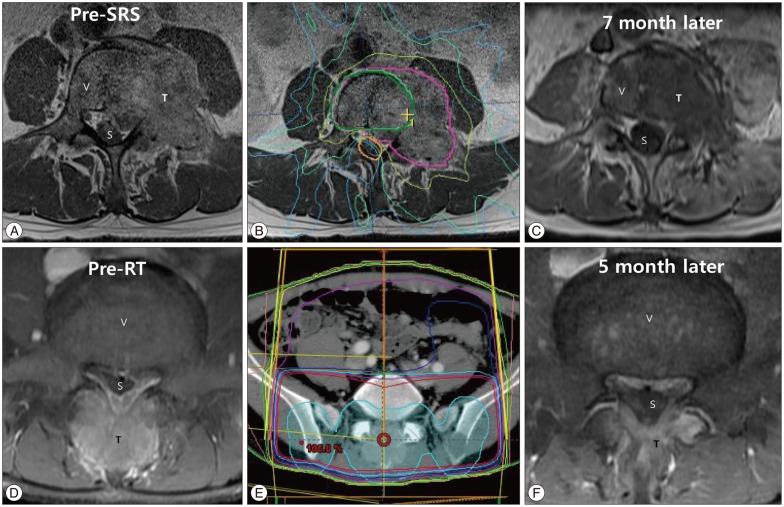
Fig. 2
Kaplan-Meier estimates of overall survival did not differ between SRS and RT groups (p=0.85). Median overall survival after treatment was 8 months in the SRS group and 10 months in the RT group. SRS : stereotactic radiosurgery, RT : external radiation therapy.
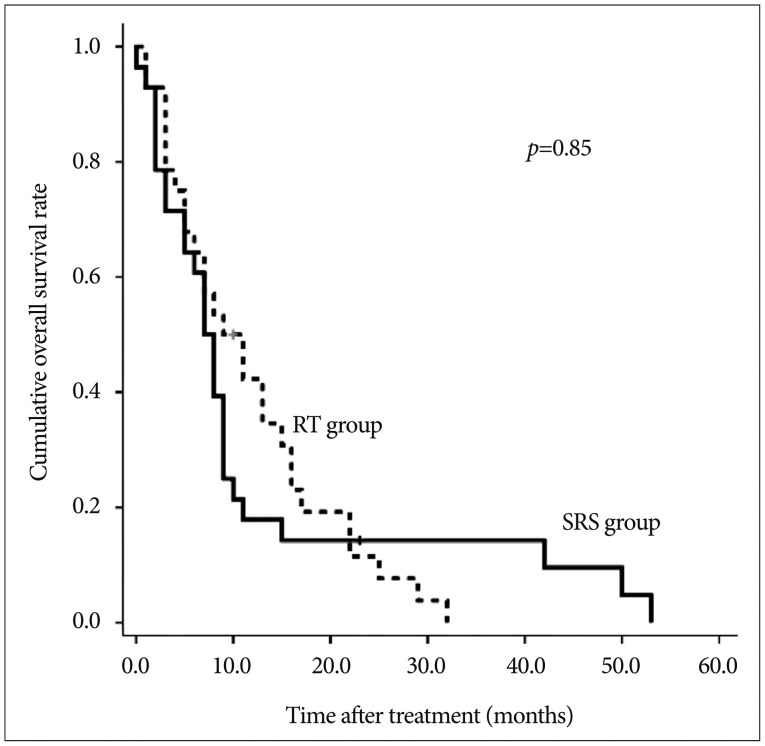
Fig. 3
Kaplan-Meier estimates of progression free survival did not differ significantly between the SRS and RT groups (p=0.48). Median progression free survival after treatment was 10 months in the SRS group and 8 months in the RT group. SRS : stereotactic radiosurgery, RT : external radiation therapy.
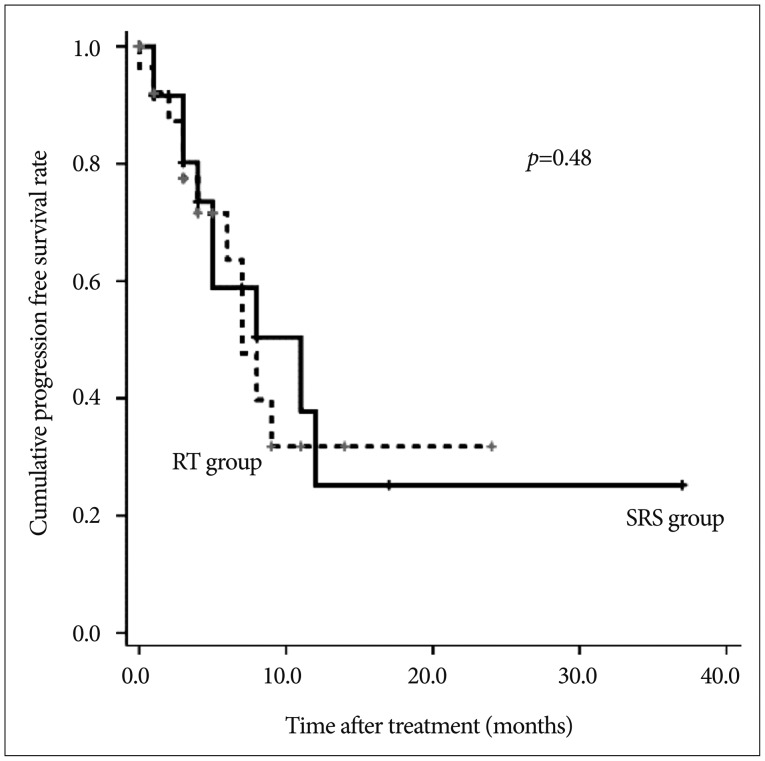




 PDF
PDF ePub
ePub Citation
Citation Print
Print


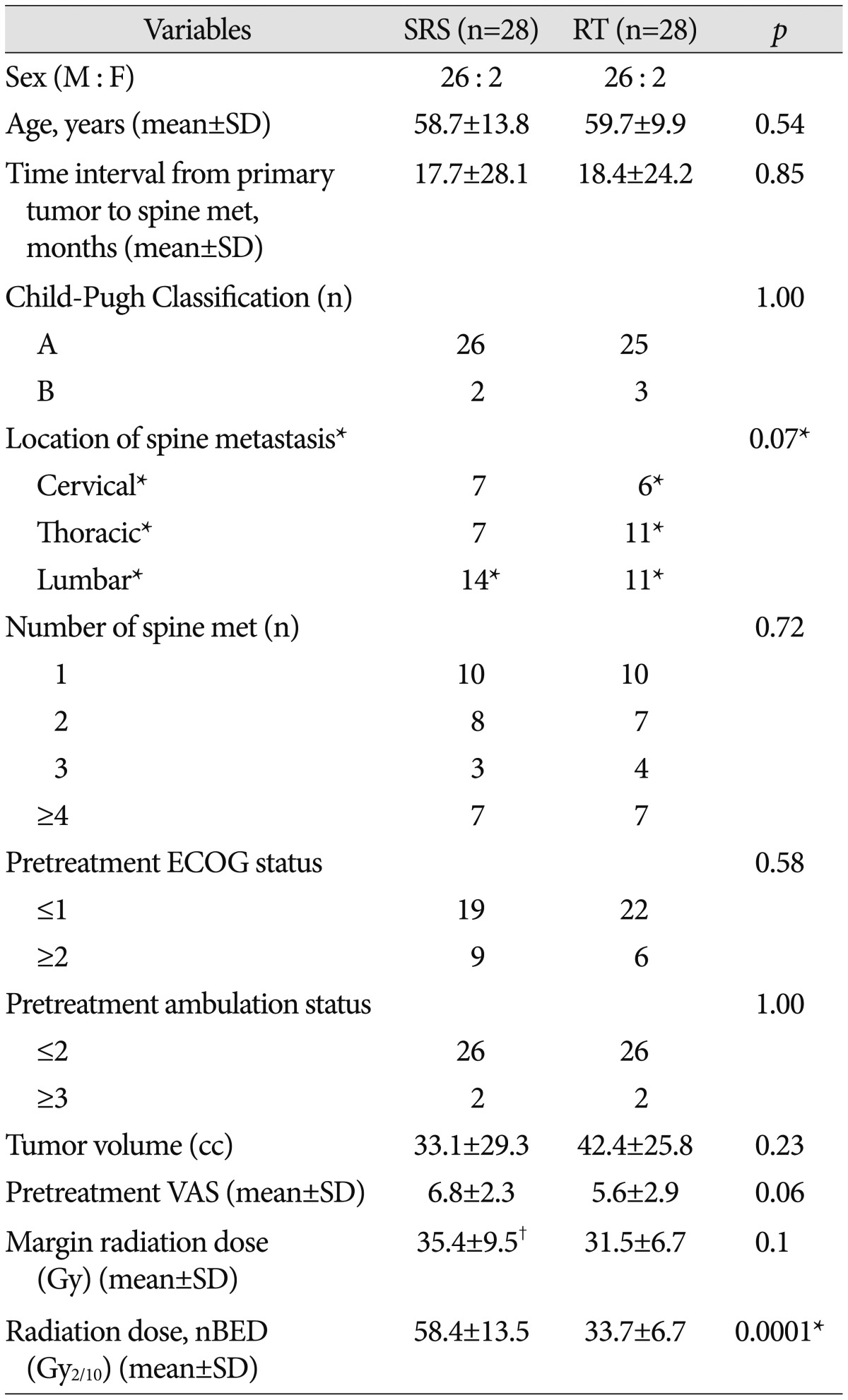
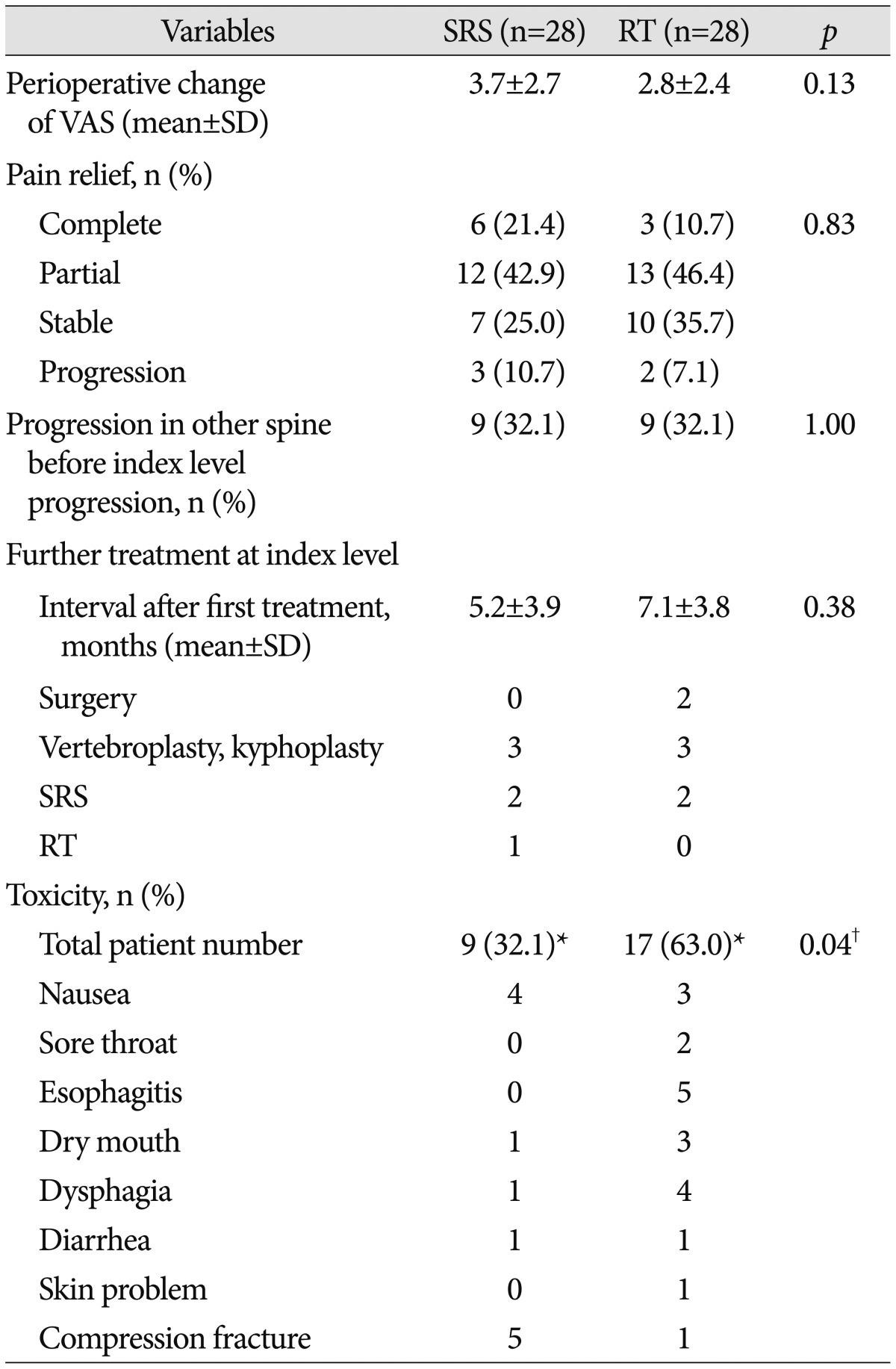

 XML Download
XML Download